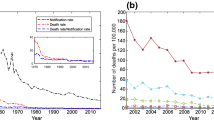Abstract
One of the unique features of bacterial diseases such as pertussis is the possibility of multiple infections during a lifetime. Immunity gained after each infection may play an important role in disease transmission dynamics. A PDE model with two infections for pertussis was considered in Feng et al. (J Theor Biol 356:123–132, 2014) and applied to the Swedish population to estimate the age-dependent probability of infection on contact. However, no detailed analysis of the dynamic properties of the model was considered in that study. Here we present the analysis including existence and stability of equilibrium solutions, which are shown to be determined by the effective (or basic) reproduction number \({\mathcal {R}}\) (or \({\mathcal {R}}_0\)). We also extend the model in Feng et al. (2014) to allow three infections during a lifetime. And we derive the age-specific probability of infection during a lifetime, denoted by F(a), using two approaches: one uses the model solutions, and the other one is based on biological interpretations. Numerical explorations of the model suggest that, with reasonable assumptions, two infections are all that one needs to consider to account for the dynamics of this disease. This increases the importance of the analytic results from the 2-infection model. Nonetheless, the formula for F(a) in the 3-infection model may provide more accurate description for the probability of infection because it permits more realistic distributions for waiting times in disease stages.


Similar content being viewed by others
References
Ad hoc group for the study of pertussis vaccines, Placebo-controlled trial of two acellular pertussis vaccines in Sweden–protective efficacy and adverse events. Lancet 1, 955–960 (1988)
Busenberg, S.N., Van den Driessche, P.: Analysis of a disease transmission model in a population with varying size. J. Math. Biol. 28, 1065–1080 (1990)
Saylers, A.A., Whitt, D.D.: Bacterial Pathogenesis: A Molecular Approach. ASM, Washington, DC (1994)
Castillo-Chavez, C., Feng, Z.: Global stability of an age-structured model for TB and its applications to optimal vaccination strategies. Math. Biosci. 151, 135–154 (1998)
Castillo Chavez, C., Hethcote, H.W., Andreasen, V., Levin, S.A., Liu, W.M.: Epidemiological models with age-structure, proportionate mixing, and cross-immunity. J. Math. Biol. 27(3), 233–258 (1989)
Farrington, C.P.: Modeling risks of infection for measles mumps and rubella. Stat. Med. 9, 953–967 (1990)
Feng, Z., Glasser, J.W., Hill, A.N., Frankoc, M.A., et al.: Modeling rates of infection with transient maternal antibodies and waning active immunity: application to Bordetella pertussis in Sweden. J. Theor. Biol. 356, 123–132 (2014)
Feng, Z., Han, Q., Qiu, Z., Hill, A.N., Glasser, J.W.: Computation of \({\cal{R}}\) in age-structured epidemiological models with maternal and temporary immunity. Discrete Cont. Dyn, Sys. B 21(2), 399–415 (2016)
Feng, Z., Xu, D., Zhao, H.: Epidemiological models with non-exponentially distributed disease stages and applications to disease control. Bull. Math. Biol. 69, 1511–36 (2007)
Feng, Z., Zheng, Y., Hernandez-Ceron, N., Zhao, H., Glasser, J.W.: Mathematical models of Ebola-Consequences of underlying assumptions. Math. Biosci. 277, 89–107 (2016)
Glasser, J.W., Feng, Z., Moylan, A., Del Valled, S., Castillo-Chavez, C.: Mixing in age-structured population models of infectious diseases. Math. Biosci. 235, 1–7 (2012)
Hethcote, H.W.: An immunization model for a heterogeneous population. Theor. Pop. Biol. 14(3), 338–349 (1979)
Hethcote, H.W.: Modeling Heterogeneous Mixing in Infectious Diseases Dynamics, In Models for Infectious Human Diseases, pp. 215–238. Cambridge University Press, Cambridge, UK (1996)
Hethcote, H.W.: The mathematics of infectious diseases. SIAM Rev. 42, 599–653 (2000)
Kretzschmar, M., Teunis, P.F.M., Pebody, R.G.: Incidence and reproduction numbers of pertussis: estimates from serological and social contact data in five European countries. PLoS Med. 7, e1000291 (2010)
Inaba, H.: Threshold and stability results for an age-structured epidemic model. J. Math. Biol. 28, 411–434 (1990)
Jong, M.C., Diekmann, O., Heesterbeek, J.A.P.: How does transmission of infection depend on population size? Atmos. Chem. Phys. 12(2), 4719–4754 (1994)
Mena-Lorca, J., Hethcote, H.W.: Dynamic models of infectious diseases as regulators of population sizes. J. Math. Biol. 30, 693–716 (1992)
Reichman, L.B., Hershfield, E.S.: Tuberculosis: Acomprehensive International Approach. Marcel Dekker, New York (1993)
Rouderfed, V., Becker, N., Hethcote, H.W.: Waning immunity and its effects on vaccination schedules. Math. Biosci. 124, 59–82 (1994)
Wang, X., Shi, Y., Feng, Z., Cui, J.: Evaluations of interventions using mathematical models with exponential and non-exponential distributions for disease stages: the case of ebola. B. Math. Biol. 79(9), 2149–2173 (2017)
Acknowledgements
We thank the Reviewer for careful reading of the manuscript and for many helpful comments that have improved the presentation of the paper. The research is partially supported by the Natural Science Foundation of China (11371048 and 11701026), the BUCEA Post Graduate Teaching Quality Improvement Project (J2017008), the BUCEA Post Graduate Innovation Project (PG2017031), and the BUCEA Basic Research Operating Costs for 2018 Projects (ZC05, FZ03).
Author information
Authors and Affiliations
Corresponding authors
Rights and permissions
About this article
Cite this article
Wang, X., Shi, Y., Cui, J. et al. Analysis of Age-Structured Pertussis Models with Multiple Infections During a Lifetime. J Dyn Diff Equat 31, 2145–2163 (2019). https://doi.org/10.1007/s10884-018-9680-0
Received:
Revised:
Published:
Issue Date:
DOI: https://doi.org/10.1007/s10884-018-9680-0




